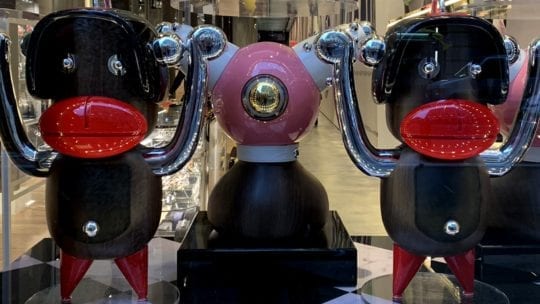
Prada is in hot water after releasing a product that many on social media are calling racist.
In an effort to rejuvenate the fashion brand after three years of falling sales, Prada has launched a Pradamalia line of figurines and accessories, which includes black and brown monkey-shaped figures featuring oversized red lips, a defining characteristic of blackface.
Social media users were quick to point out the figurines' resemblance to the 1930s and 1940s-era blackface merchandise and corresponding racist implications. The products were brought to light by New York City lawyer Chinyere Ezie, who posted about her encounter with the figurines on Facebook:
This is not the first time in recent history that visual representations of blackface and minstrelsy have made their way onto product shelves. In January, H&M came under fire after an image of a black boy modeling a sweatshirt that read "Coolest Monkey In the Jungle" hit social media.
Following the backlash, Prada quickly removed the product from circulation. In a statement, the fashion brand said, "They are imaginary creatures not intended to have any reference to the real world and certainly not blackface. Prada Group never had the intention of offending anyone and we abhor all forms of racism and racist imagery. In this interest, we will withdraw all of the characters in question from display and circulation."
The brand reacted quickly, but not fast enough to stop history repeating itself. While the brand deserves some credit for its fast response as a result of monitoring negative social media comments and media mentions, the company did not directly apologize or take responsibility for the product's creation in the statement. This begs the question: How can the brand ensures it doesn't repeat its own—and other major brands'—mistakes in the future?
Branding missteps start at the C-level. Communicators who specialize in ensuring their clients maintain racial and cultural sensitivity in all of their campaigns often argue that true disconnects start at the top. This means that executives who sign off on products and campaigns before they are launched should always come from diverse backgrounds. That includes educational background, geographic location, age, race, gender, ethnicity and sexual orientation.
Take a look around the conference room. “If you realize your whole marketing department is made up of white people who went to Ivy League schools, you need to figure out how to bring in additional voices,” says Jessica Fish, founder of the startup Inclusiv Us, who regularly works with brands to ensure their messaging doesn't miss the mark in terms of gender, race or cultural identity. “Because unless your demographic is ‘white people who went to Ivy League schools,’ you’re going to miss the mark.”
Conduct regular internal audits and unconscious bias training. Fish holds that all brands would benefit from a "sustained investigation around how implicit biases present themselves inside the workplace."
She recommends the following resources for internal communicators committed to enacting inclusivity programs with staying power:
- Google's re:Work articles on "unbiasing"
- A 2016 study on unconscious bias by University of North Carolina Executive Development program director Horace McCormick
- Taking and disseminating one of Harvard's implicit bias tests
There's an ROI to getting it right. Whether Prada decides to issue a fuller apology and/or deploy better training internally, being proactive wouldn't just be a mark of "doing the right thing." There's a business case to be made for building a framework to avoid missing the mark in the future. It would certainly save resources on recalled products and crisis management.
Follow Sophie: @SophieMaerowitz
Follow Jessica: @fishica
